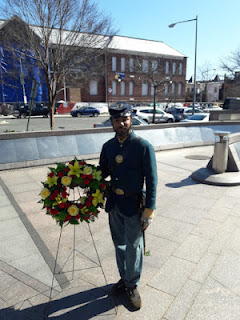"Our histories are connected! We are acknowledging our African connection.”
---Marquett Milton
the African American Civil War Memorial and Museum in Washington, DC
[This blog post was originally written and published in March 2020. It is presented to you as an example of ethnic marketing for the good. Images may be subject to copyright.]
A great example of ethnic marketing was demonstrated by the late Professor Hari Jones, the former curator and assistant director of the African American Civil War Memorial and Museum in Washington, DC. Every March 1st African Americans and Ethiopians gather to honor their African ancestry and identity with a wreath laying at the African American Civil War Memorial commemorating the victory of Adwa, Ethiopia on March 1, 1896.
Next, is a portion of the same video. A few people arrived to start the event, and more arrived later. Every year has been a multi-cultural crowd. The video shows Mr. D. Overby representing soldiers of Afro-descent throughout the Americas. He symbolizes the legacy of Afro-descent soldiers in the U.S. military. It is important for you to also know that U.S. Civil War veterans knew of the Adwa victory.
THE AFRICAN AMERICAN CIVIL WAR MEMORIAL
The memorial remembers the lives and legacy of the United States Colored Troops also known as the USCT. According to Thomas Morris Chester, the only African descent U.S. Civil War correspondent, the USCT were the the first of the U.S. government forces to enter and capture Richmond, Virginia the then capital of the Confederate forces on April 3, 1865. Their victory set the grounds for the end of the Civil War with the signing of surrender at Appomattox, Virginia on April 9, 1865.
THE ADWA VICTORY
The Shaw community in Washington, DC is Pan African with cultures and ethnic people groups, of both Africans and Afro-descendants from throughout the Americas, Ethiopia, Eritrea, Nigeria, Ghana and more. The memorial, the museum, Howard University and Little Ethiopia are all located in the Shaw community. The wreath laying event is a community celebration with individuals and organizations following the leadership of the museum, and Little Ethiopia. Over the years notable faces have attended the wreath laying event. The wreath is decorated with the colors of the Ethiopian national flag. The Shaw community is named after U.S. Civil War Colonel Robert Gould Shaw.
LITTLE ETHIOPIA
Little Ethiopia is located on 9th Street, NW in Washington, DC between U Street, NW (on the north) and T Street, NW (on the south)--NW stands for northwest) and may one day extend further south, and made official in December 2020.
When it comes to modern borders what we now call Ethiopia, Eritrea, Somalia, and Djibouti was all once called Abyssinia or Habesha. Over time the idea of Habesha was reduced to the modern country of Ethiopia, and the ethnic Amhara people. But the battle and victory at Adwa included everyone from the original Abyssinia map.
1896...AND THE GLOBAL REACTION
In 1896 the victory at Adwa was reported in newspapers all over the world, with quotes from leaders around the world. Those leaders did not think Ethiopia had a chance to resist Italy. Many African Americans were proud of Ethiopia resisting colonization and felt an affinity to Ethiopia. Since then, Ethiopians worldwide celebrated the Adwa victory.
When we think on Adwa we must know that the First Italian-Ethiopian War was sparked by the words of a treaty between Italy and Ethiopia. Ethiopia's copy of the treaty read different from the one written in Italian. The treaty positioned Ethiopia to be a protectorate of Italy and stated that they had to inform Italy of any contact they would have with another nation.
After discovering this the Ethiopian Emperor Menelik II and his wife Empress Taytu Betul united Ethiopia for the fight. Empress Taytu was famous for her taking the battlefield along with her husband (seen in the painting below). The deciding battle in Adwa was fought for two days. Their unification of all the ethnic groups to unite and fight resonated around the world. This is why the victory is called a Pan African victory.
THE AFRICAN CONNECTION IN THE USA
In the past what we call the U.S. Civil War was called the War of the Rebellion (1861-1865). When men of African descent joined the war, it was 1863 and they helped to outnumber the Confederacy and turned the tide of that war. In fact, men of African descent made up ten percent of the Northern Army, or what they called the Union Army.
During legal enslavement and since, African Americans held a deep affinity to Africa, its politics and people. They named their institutions Africa or African. Examples are the African Lodge, the African Free School, the African Methodist Episcopal Zion Church and more.
It is a myth created by slave owners that enslaved Africans accepted or wanted to be enslaved. However, both enslaved and free Africans in the Americas resisted enslavement using violence, non-violence, diplomacy, pamphlets and so much more. This was seen in the lives of Prince Hall, Frederick Douglass, Elizabeth Keckley, Prince Abdul Rahman Ibrahima Sori, David Walker, Maria W. Stewart, Denmark Vesey, Nat Turner, Harriet Tubman, Mary Ann Shadd Cary, Phyllis Wheatley, Martin Delany and many more.
This was also seen in the work of the Underground Railroad. A network founded by African Americans that included people of many nationalities who believed in freedom and liberty. For many of that generation their work not only to end chattel slavery, but to become full American citizens in league with the United States Constitution.



.jpg)


.jpg)


.JPG)
No comments:
Post a Comment